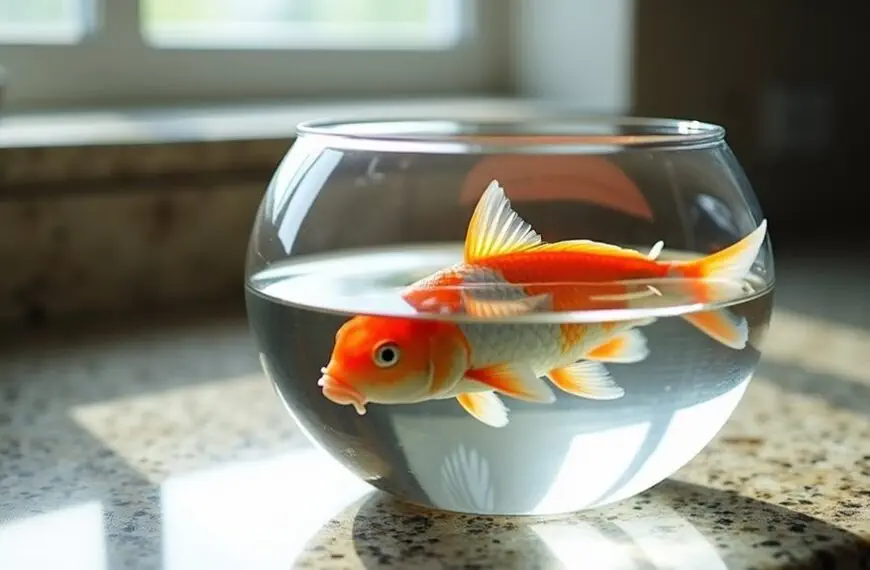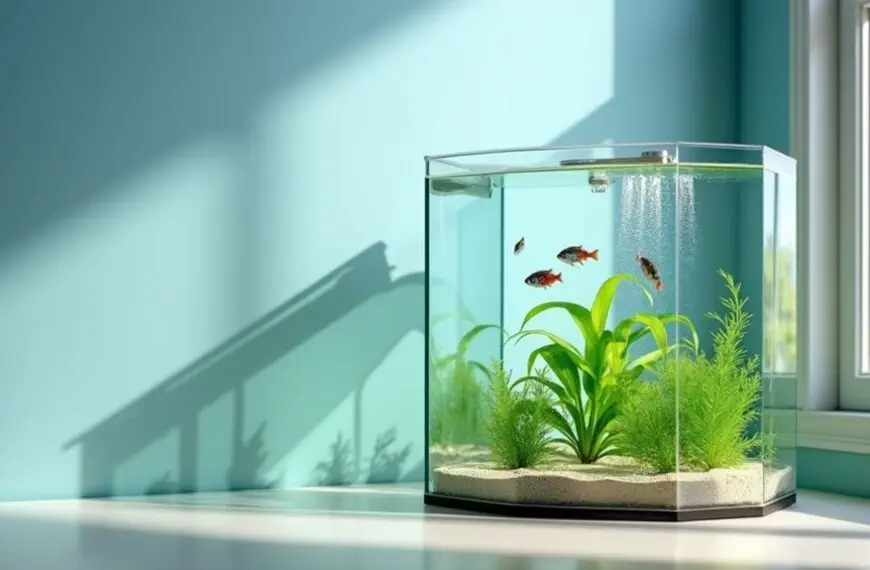You'll need to feed most adult fish once per day, while younger fish might need up to three smaller meals daily for proper growth. It's important to establish a consistent feeding schedule and remove any uneaten food after 15 minutes to maintain water quality. Watch for signs of hunger like excited swimming or following your movements near the tank, and don't worry too much about slightly underfeeding – it's actually safer than overfeeding! Different species have unique needs, with some preferring multiple small meals and others thriving on fewer, larger portions. There's a whole world of feeding patterns to explore for your specific finned friends.
Contents
- 1 Understanding Basic Fish Feeding Patterns
- 2 Common Fish Feeding Mistakes
- 3 Signs of Hunger in Fish
- 4 Different Fish Species Feeding Requirements
- 5 Best Times to Feed Fish
- 6 Choosing the Right Food Portions
- 7 Water Quality and Feeding
- 8 Feeding During Vacation Periods
- 9 Frequently Asked Questions
- 10 Final Thoughts
Understanding Basic Fish Feeding Patterns
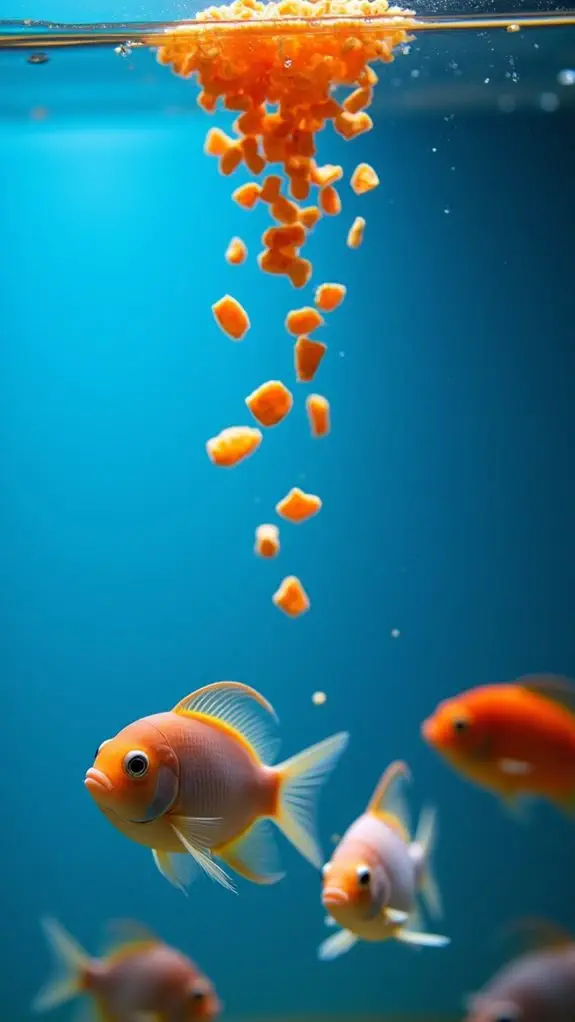
In most home aquariums, maintaining a proper feeding schedule is vital for your fish's health and well-being. While you might think your fish are constantly hungry (they'll certainly try to convince you they are!), most species actually thrive with just one feeding per day. Fish need to be fed at least 10 minutes after turning on the tank lights to ensure they're fully awake and ready to eat. Fish naturally tend to eat opportunistically, making it important to establish consistent feeding times. Additionally, providing a varied diet that includes both high-quality pellets and live or frozen options can enhance their overall health.
Understanding feeding frequency and fish behavior will help you create the perfect mealtime routine for your aquatic friends. Your fish's dietary needs will vary based on their species and age. If you've got young, growing fish, they'll need more frequent meals – up to three times daily.
Most adult carnivores and omnivores are perfectly content with one or two daily feedings, while herbivores like silver dollars and mollies prefer several smaller meals throughout the day. Think of them as the grazers of the underwater world!
Don't worry too much about exact feeding times – they're not critical for most fish. However, if you're keeping nocturnal species, you'll want to feed them after turning off the aquarium lights. This matches their natural feeding patterns and guarantees they won't miss out on their meals while hiding during the day.
Common Fish Feeding Mistakes
The most damaging mistakes in fish care often revolve around feeding habits. When you're excited about your new aquatic friends, it's tempting to shower them with food, but overfeeding consequences can be severe. If you're tossing in more food than your fish can eat in a minute, you're actually putting their health at risk – those leftovers break down and release harmful chemicals into the water. Setting up a consistent feeding schedule helps maintain your fish's natural eating patterns. Regular small portions 2-3 times daily is ideal for most aquarium fish, especially for species like Guppies(Guppies).
You'll also want to avoid the common trap of grabbing any fish food off the shelf. Just like humans, different fish species have specific dietary needs, and nutritional deficiencies can lead to serious health issues. For instance, baby fish need protein-rich foods like brine shrimp, while adult fish might require different formulations.
Don't forget about size matters, too! If you're feeding large pellets to tiny fish, they'll struggle to eat them. Break up those food particles into manageable bites, and consider soaking dry food first.
Remember to clean up any uneaten food promptly – think of it as clearing the dinner table after a meal. Your fish will thank you with vibrant colors and active behavior!
Signs of Hunger in Fish

Knowing when your fish are truly hungry can save you from both overfeeding and underfeeding problems. Your aquatic friends will display clear hunger signals that you'll want to learn to recognize. They'll often swim excitedly to the surface when they're ready for a meal, especially during their usual feeding times. Feed your fish in consistent locations daily to establish healthy eating patterns.
It's important to remember that different species have varying dietary needs, and some may require specific foods to thrive.
Watch for specific feeding behavior that indicates genuine hunger. If you notice your fish following your movements near the tank or "begging" by swimming up to the glass, they're probably ready for their next meal. Healthy fish display active foraging behavior and increased swimming speed during regular feeding times.
However, don't be fooled – sometimes fish act hungry out of habit rather than actual need!
There are also physical signs that'll tell you if you're not feeding enough. A sunken belly, dull colors, or visible bones under tight skin are red flags that your fish aren't getting sufficient nutrition.
You'll want to adjust their feeding schedule if you spot these warning signs. Think of it like how we get "hangry" – fish can show similar signs of distress when they're underfed.
Different Fish Species Feeding Requirements
Your tropical fish's eating patterns will vary greatly depending on where they naturally feed in the water column. Surface feeders need more frequent meals than bottom dwellers. For example, species like neon tetras benefit from schooling behavior which influences their feeding habits as they feel more secure in groups while eating. You'll notice that carnivorous fish like bettas and cichlids don't need to eat as often as herbivores, since they're built to handle larger, protein-rich meals less frequently. A balanced diet schedule is essential for maintaining optimal fish health and growth. Young fish require more frequent feedings compared to adult fish. If you've got bottom feeders like corydoras or plecos, they'll do best with sinking pellets or tablets that reach their preferred feeding zone near the tank floor.
Tropical Fish Eating Patterns
Understanding tropical fish feeding patterns starts with recognizing that different species have distinct dietary needs and eating frequencies.
You'll notice that tropical fish behavior around feeding time can be quite entertaining – they might swim excitedly to the top of the tank, but don't let their "puppy dog eyes" fool you into overfeeding!
Most tropical fish do well with one or two small meals per day, but there's no one-size-fits-all approach to feeding frequency. It's best to only provide what your fish can consume in two minutes time. Additionally, maintaining proper water quality through regular feeding routines will help prevent stress and health issues in your fish.
If you've got young, growing fish, they'll need more frequent meals – usually three or more times daily.
Herbivores like mollies and silver dollars have smaller stomachs, so they'll benefit from several smaller portions throughout the day. Healthy adult fish can actually go several days without food, similar to their natural feeding patterns.
Your nocturnal fish need special attention, too. They're not being picky eaters – they just prefer dining after dark!
Make sure to feed these night owls after you've turned off the lights.
Remember that different food types might require adjusting your feeding schedule. Whether you're using flakes, pellets, or live food, you'll want to watch carefully to guarantee your fish are getting just the right amount without leaving leftovers that could harm water quality.
Bottom Feeders vs. Surface
Fish feeding habits vary dramatically between surface dwellers and bottom feeders, creating distinct challenges for aquarium owners.
When it comes to surface feeder feeding, you'll want to offer food shortly after your aquarium lights turn on, as these fish are most active during daylight hours. They'll enthusiastically snap up floating foods that stay suspended in the water column, making feeding time an exciting spectacle.
Bottom feeder feeding requires a different approach altogether. These nocturnal nibblers prefer their dinner served after dark, so you'll want to wait until the lights go out before dropping in their sinking pellets or tablets.
They're like the night shift workers of your aquarium, preferring to dine when their tank mates are snoozing above. You'll need to guarantee their food reaches the substrate where they can easily find it.
Carnivores Need Less Food
Carnivorous fish don't need to eat as frequently as their herbivorous cousins. Their feeding habits are quite different, as they're designed to consume larger, protein-rich meals that sustain them for longer periods.
You'll find that most carnivorous fish do perfectly well with just one meal per day, while some larger predators might only need to eat a few times a week.
When it comes to feeding your carnivorous fish, here are three essential guidelines to follow:
- Monitor portion sizes carefully – it's better to slightly underfeed than overfeed
- Remove uneaten food within 15 minutes to maintain water quality
- Include regular fasting days to mimic natural feeding patterns
Remember that younger carnivorous fish might need more frequent meals than adults, but don't let those pleading eyes fool you! They're masters at begging for extra food, even when they don't need it.
Additionally, providing a varied diet of high-quality foods is crucial for ensuring overall health, as many fish benefit from a balanced intake including high-protein foods to thrive.
You'll want to focus on quality over quantity, offering high-protein foods like frozen shrimp or specialized carnivore pellets. By maintaining a consistent feeding schedule and watching your fish's behavior, you'll quickly learn their ideal feeding pattern.
Best Times to Feed Fish
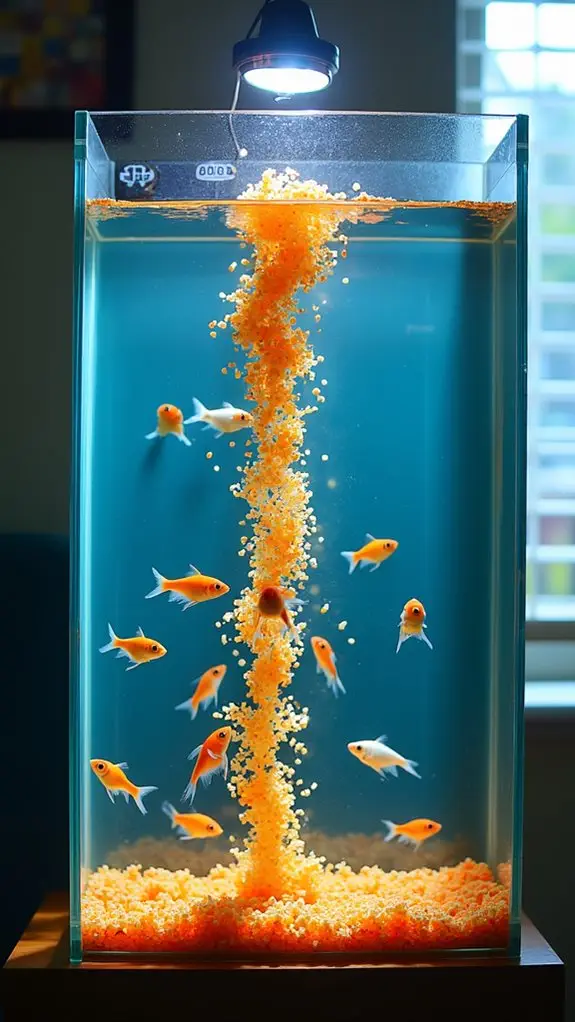
If you're wondering about the perfect time to feed your fish, you'll want to match their natural eating patterns, which typically means offering food in the morning or evening hours when they're most active.
Whether you choose morning or evening feedings (or both), you should wait at least 10-15 minutes after turning on your aquarium lights to guarantee your fish are fully awake and ready to eat.
Your fish's specific species and lifestyle will guide your timing choices – for example, if you've got nocturnal fish like plecos, you'll need to feed them after the lights go out.
Morning Vs Evening Feeding
When it comes to feeding your aquatic pets, timing plays an essential role in their health and well-being. Morning feeding offers several advantages, as your fish are naturally more active during daylight hours and can better process their food throughout the day.
You'll also have an easier time observing their behavior and adjusting portions as needed.
Evening feeding, however, has its own benefits, especially if you've got nocturnal species like plecos in your tank. It's also a peaceful time to bond with your fish and can help distribute their energy levels throughout the day.
Here are three key factors to take into account when choosing between morning and evening feeding:
- Your fish's natural behavior patterns – match feeding times to when they're most active
- Your daily schedule – consistency is essential, so pick times you can maintain
- Tank community mix – if you have both day and night-active fish, you might need both feeding times
Natural Feeding Rhythms
Understanding your fish's natural feeding rhythms is key to maintaining their health and energy. Just like humans have preferred meal times, fish follow specific diurnal patterns that dictate when they're most active and ready to eat.
You'll notice that fish who are fed at consistent times will actually start showing excitement before mealtime, displaying increased activity and hormone levels.
When you're setting up a feeding schedule, it's important to match your fish's natural feeding habits. Most fish do better with smaller, more frequent meals rather than one large feeding.
You'll want to avoid overfeeding, though, as fish won't naturally stop eating when they're full – they're opportunistic feeders in the wild! Different species have varying needs: some might thrive on two or three small meals daily, while others do fine with feeding every other day.
Meal Timing Guidelines
Establishing proper meal times for your aquarium fish requires a careful balance of species-specific needs and practical timing. Your feeding frequency will vary depending on your fish species, but most fish do well with once or twice daily feedings. Remember that meal duration should only last between 2-5 minutes – if your fish aren't finishing their food in this time frame, you're likely offering too much.
For the best results with your aquarium feeding schedule, follow these key guidelines:
- Feed nocturnal fish right before turning off the lights, as they're most active during darker hours.
- Start with feeding every other day in newly established tanks, gradually increasing to daily feedings as water parameters stabilize.
- Reduce feeding amounts when water temperatures drop, as fish's metabolism slows in cooler conditions.
If you're keeping different species together, you'll need to adjust your timing to accommodate everyone's needs. For example, herbivorous fish and goldfish need more frequent, smaller meals throughout the day, while carnivorous fish can manage with fewer, larger feedings.
Don't worry if you can't feed at exactly the same time each day – most fish are quite adaptable to slight schedule variations. Additionally, regular water changes are crucial for maintaining water quality and ensuring a healthy environment for your fish, as poor water quality can affect their overall health and feeding habits.
Choosing the Right Food Portions
Determining the right food portions for your fish is essential for their health and your tank's water quality. The best way to measure portion size is to observe how much your fish can eat within five minutes. You'll want to use proper feeding tools, like automatic feeders or measured scoops, to maintain consistency in your portions.
When you're first establishing the right amount, start with a smaller portion and watch your fish's behavior. If they seem enthusiastic for more after eating everything, you can gradually increase the amount. Remember, it's better to underfeed than overfeed – your fish won't be shy about letting you know they're still hungry!
Keep an eye out for any uneaten food floating around, and remove it promptly to prevent water contamination. Different species have varying appetites, so you'll need to adjust accordingly. To ensure optimal fish health, it's also important to monitor water quality parameters that can be affected by overfeeding.
While juvenile fish might need more frequent, smaller portions to support their growth, adult fish typically do well with measured portions once or twice daily. If you're using an automatic feeder, make sure to test the portions it dispenses before relying on it completely.
Water Quality and Feeding
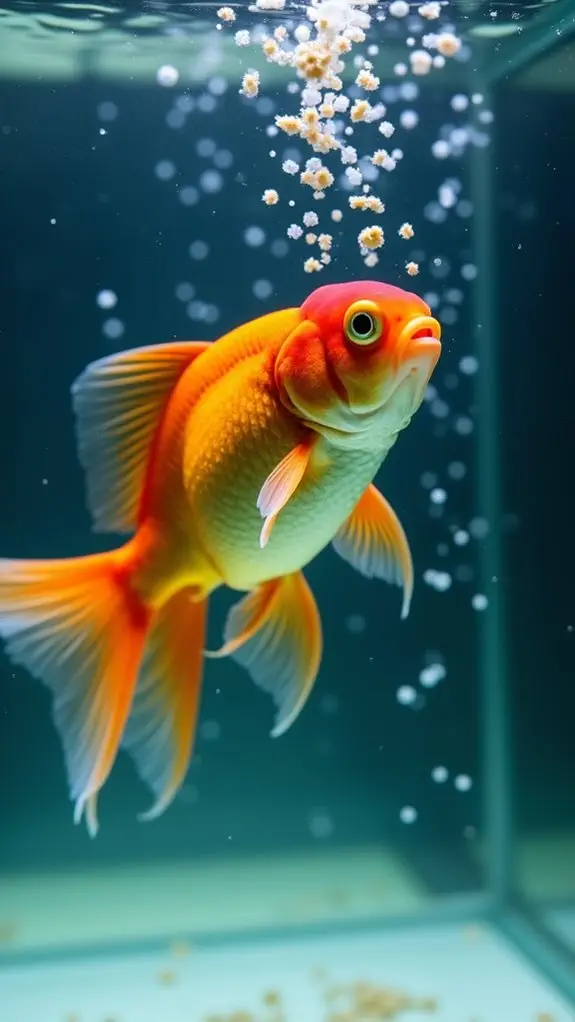
Water quality and feeding schedules are deeply interconnected in any fish tank ecosystem. When you feed your fish, you're not just filling their bellies – you're directly impacting the water they live in.
Your feeding strategies need to take into account both your fish's nutritional needs and how the food affects their environment. You'll want to maintain a careful balance between keeping your fish well-fed and preserving water quality.
Here's what you need to monitor:
- Temperature levels – they'll affect how quickly your fish digest food and how much oxygen they need.
- Dissolved oxygen content – more frequent feeding requires higher oxygen levels.
- Electrical conductivity – which changes based on your feeding schedule.
If you're feeding multiple times per day, you'll need strong filtration to handle the increased waste. Regular testing of water parameters is essential to ensure that the feeding is not compromising the aquarium's health.
Don't worry too much if you need to fast your fish occasionally – most species, including tilapia, can handle one fasting day per week without any growth problems.
With proper water quality management and a well-planned feeding schedule, you'll create an environment where your fish can thrive while keeping maintenance manageable.
Feeding During Vacation Periods
Successful vacation planning for fish owners requires careful consideration of feeding arrangements. You've got several options to guarantee your finned friends stay healthy while you're away, and each method has its own perks and considerations.
If you're heading out for a short trip, automatic feeders can be your best friend. These reliable devices will dispense precise amounts of food at set times, though they'll cost you between $25-60.
For budget-conscious owners, vacation feeding blocks might work, but be careful – they can mess with your water quality and aren't very nutritious.
For longer getaways, consider hiring fish sitters who'll keep your aquatic pals well-fed and monitored. Just remember to pre-measure meals and leave clear instructions – nobody wants an overzealous sitter turning your fish into little swimming basketballs!
If you've got healthy adult cold-water fish, they can actually handle a week or two without food. It's surprising, but fish are pretty resilient creatures.
Just don't try to make up for lost meals when you return – overfeeding is much worse than a brief fasting period for your scaly companions.
Frequently Asked Questions
Can Fish Recognize Their Owners During Feeding Time?
Yes, you'll find that fish can recognize their owners through facial features and feeding behavior. They'll often show excitement when they spot you, having learned to associate your presence with mealtime.
Why Do Some Fish Spit Out Their Food Immediately After Eating?
Your fish's feeding behavior may include spitting food for several reasons: they're testing the food, experiencing digestive issues, or dealing with stress. They might also spit food that's too large or unpalatable.
Should I Feed My Fish Differently During Breeding Seasons?
Yes, you'll need to increase feedings to 3-5 times daily during breeding behavior. Offer high-protein foods like bloodworms and brine shrimp to support dietary changes and promote successful reproduction in your fish.
How Does Water Temperature Affect Fish Feeding Requirements?
As water temperature rises, your fish's metabolism rates increase, requiring more frequent feeding. When it's colder, they'll need less food since their digestion slows down. Always adjust portions based on water temperature.
Can Fish Die From Eating Too Much at Once?
Yes, your fish can die from overeating. You'll notice overfeeding symptoms like severe bloating, difficulty swimming, and digestive issues. Stick to a proper feeding schedule to prevent fatal complications from excessive food consumption.
Final Thoughts
Feeding your fish properly doesn't have to be complicated. You'll get better results by sticking to a consistent schedule and watching your fish's behavior for hunger cues. Remember, it's better to slightly underfeed than overfeed, and you'll want to adjust portions based on your specific species. Keep the water clean, plan for vacations, and you'll have happy, healthy fish that bring life to your aquarium for years to come.


